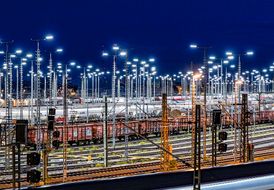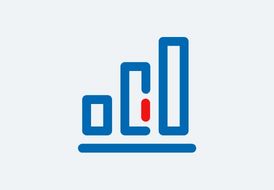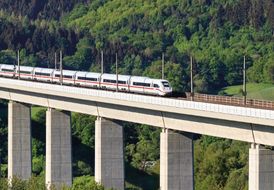Development in the year under review
- There was a marked recovery in demand since April, although the trend was hampered by floods, a wage dispute and new Covid-19 restrictions.
- Punctuality was impacted by increased utilization, capacity bottlenecks and extreme weather events.
| DB LONG-DISTANCE | 2021 | 2020 | Change | 2019 | ||
absolute | % | |||||
Punctuality (rail) (%) | 75.2 | 81.8 | –6.6 | – | 75.9 | |
Customer satisfaction (SI) | 77.8 | 80.2 | –2.4 | – | 76.5 | |
BahnCards (thousand) | 4,558 | 4,833 | –275 | –5.7 | 5,292 | |
Passengers (rail) (million) | 81.9 | 81.3 | +0.6 | +0.7 | 150.7 | |
Passengers (long-distance bus) 1) (million) | – | 0.2 | –0.2 | –100 | 0.7 | |
Volume sold (rail) (million pkm) | 24,762 | 23,542 | +1,220 | +5.2 | 44,151 | |
Volume sold (long-distance bus) 1) (million pkm) | – | 48.3 | –48.3 | –100 | 173.2 | |
Volume produced (million train-path km) | 144.4 | 141.7 | +2.7 | +1.9 | 145.7 | |
Load factor (%) | 31.4 | 30.7 | +0.7 | – | 56.1 | |
Total revenues (€ million) | 2,911 | 2,879 | +32 | +1.1 | 4,985 | |
External revenues (€ million) | 2,792 | 2,753 | +39 | +1.4 | 4,824 | |
EBITDA adjusted (€ million) | –1,434 | –1,337 | –97 | +7.3 | 789 | |
EBIT adjusted (€ million) | –1,790 | –1,681 | –109 | +6.5 | 485 | |
Gross capital expenditures (€ million) | 1,507 | 1,290 | +217 | +16.8 | 1,241 | |
Employees as of Dec 31 (FTE) | 18,790 | 18,794 | –4 | – | 17,289 | |
Annual average employees (FTE) | 18,961 | 18,332 | +629 | +3.4 | 17,036 | |
Employee satisfaction (SI) | – | 3.9 | – | – | ‒ | |
Share of women as of Dec 31 (%) | 26.9 | 27.3 | –0.4 | – | 27.2 | |
Specific final energy consumption compared to 2006 (based on pkm) (%) | +16.8 | +18.9 | –2.1 | – | –31.5 | |
1) Bus services were discontinued in late 2020.
The punctuality of DB Long-Distance declined in 2021. In addition to higher capacity bottlenecks on the network as a result of increased construction activity and higher capacity utilization, there were also negative impacts from extreme weather events (including a severe winter, storms and floods) and the wage dispute with the GDL. The further reduction of primary disruptions (including in command and control technology and in vehicles) thanks to improved availability of vehicles and infrastructure had a compensating effect.
As a result, customer satisfaction has also declined. As well as the decrease in punctuality, there was also a negative effect from the wage dispute with the GDL and service restrictions (including in the catering service) due to the decreased demand caused by Covid-19. To assess customer satisfaction, about 20,000 customers were asked in six waves about their satisfaction with the current journey.
The number of BahnCard holders also decreased further as a result of the Covid-19 pandemic. This affected all types of BahnCard.
The performance development only experienced a slight recovery, although it should be noted that the first quarter of 2020 was not significantly impacted by the Covid-19 effects:
- The extension of the Covid-19 pandemic containment measures in early 2021 led to a significant decline in the number of passengers and volume sold. Increases in demand, which were significant at times, were recorded as the measures were increasingly loosened from April 2021 onwards. In addition, the wage dispute with the GDL and the effects of extreme weather events had a negative impact.
- Volume produced also increased slightly. Positive effects from fewer Covid-19 restrictions and the expansion of available services were greater than the negative effects from construction activities on the network and the GDL strikes.
- Load factor increased again as a result of the increased number of passengers.
As a result of the disproportionate increase particularly in cost of materials and personnel expenses compared to income, the operating profit figures fell.
Income increased mainly as a result of increased demand:
- The recovery in demand led to a slight increase in revenues.
- Other operating income (+28.8%/€ +60 million) increased significantly, particularly as a result of higher income from insurance benefits (for loss events in previous years), international transport and sales of vehicles.
Expenses increased, largely as a result of higher material costs due to price and volume increases and increased personnel costs:
- The increase in the cost of materials (+3.7%/€ +99 million) was largely a result of higher infrastructure and energy expenses due to price and volume increases, as well as more intensive maintenance activities. Reductions in expenses resulted from a reduced use of goods in on-board catering due to the Covid-19 pandemic, commissions and the disposal of Ameropa in the previous year. The discontinuation of long-distance bus activities also had a dampening effect.
- The increased personnel expenses (+7.1%/€ +80 million) resulted primarily from increases in collective bargaining agreements and a greater average number of employees.
- Depreciation rose slightly (+3.5%/€ +12 million). Higher depreciation due to the addition of ICE 4 and Intercity 2 trains was largely compensated for by the effects of ICE and Intercity trains reaching the end of their useful life for accounting purposes.
- Other operating expenses remained virtually unchanged (+0.7%/€ +4 million). Higher expenses, including from losses from disposals of facilities and for marketing, were largely offset, mainly by decreased project costs.
Capital expenditure activities rose to a very high level, resulting primarily from continued vehicle projects.
The number of employees as of December 31, 2021 was slightly above the previous year’s level.
The share of women decreased slightly.
The specific final energy consumption was still above its level in the reference year, 2006, as a result of persistently low demand due to the Covid-19 pandemic, although it improved slightly compared to the previous year. Nevertheless, the energy efficiency of train journeys improved, mainly thanks to a continuous shift of the long-distance fleet to new, more energy-efficient series. Thus there were, for example, more ICE 4s, which consume less energy on average, in use in 2021. As well as the changes to the fleet mix, we conducted more training in energy-saving driving styles.



